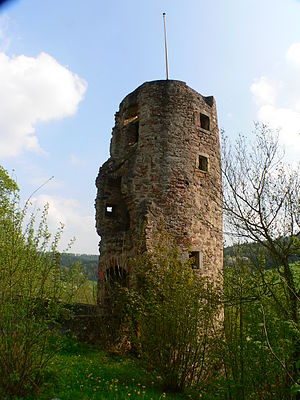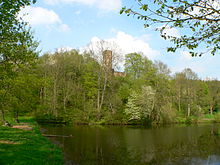Wallenstein castle ruins
| Wallenstein castle ruins | ||
|---|---|---|
| Alternative name (s): | Alt-Wallenstein | |
| Creation time : | around 1100 to 1200 | |
| Castle type : | Höhenburg, spur location | |
| Conservation status: | former stair tower as a lookout tower, surrounding wall | |
| Construction: | Keep 12 m high | |
| Place: | Knüllwald- Wallenstein | |
| Geographical location | 50 ° 57 '4 " N , 9 ° 29' 37" E | |
| Height: | 354 m above sea level NHN | |
|
|
||
The Wallenstein castle ruins are the ruins of a high medieval hilltop castle in the Wallenstein district of the North Hessian municipality of Knüllwald . The spur castle , which was probably built in the 12th century, was destroyed in the Thirty Years War and is only partially preserved today.
location
The castle ruin is located in a small side valley of the Efze in the Knüllgebirge on a mountain spur sloping to the west , 354 m above sea level . Above the castle is the 474 meter high Babloh mountain.
The next building was Neuenstein Castle about six kilometers southeast on a hilltop above Saasen , a district of Neuenstein . Both castles were on an old road that led from Hersfeld via Homberg (Efze) and Fritzlar to the Kassel area .
history
The castle was probably built by the Hersfeld Abbey in the 12th century to control the western part of the Hersfeld area after the Thuringian landgrave had established himself in Homberg and threatened herfeld possessions and rights from there. At the beginning of the 13th century, Count Albert V von Schauenburg had the castle "Waldinsteyn" in pledge possession, and from 1223 Albert named himself Albert von Wallenstein after this castle . In 1250 he sold half of the castle and the property belonging to it back to the Hersfeld Abbey. From this time onwards, Albert (I.) von Wallenstein built the probably more favorably located Neuwallenstein Castle (Neuenstein Castle), where the family's headquarters were from then on. In 1267, his son Albert II von Wallenstein joined Abbot Heinrich III. von Hersfeld signed an exchange contract to organize the goods around the two castles, with Neuenstein Castle being mentioned for the first time.
When Albert II of Wallenstein died in 1284 without heirs, the property fell to Conrad von Wallenstein, probably a brother of Albert I of Wallenstein. Conrad, who referred to Wallenstein Castle as his castle in 1290, became the founder of the new Wallenstein line. He no longer had the title of count, as in all likelihood his Schauenburg ancestors had already sold the "Ditmelle" court, with which the title of count was connected, to the Archdiocese of Mainz in the first half of the 13th century . In the course of time the castle was pawned several times; In 1332 it was owned by Simon von Homberg , who six years later gave half of it back to the Wallenstein family. At the end of the 14th century, the entire castle was again in Wallensteiner's possession.
After that the ownership changed several times. In the 15th century the lords of Elben had a share in the castle. In 1438 Archbishop Dietrich von Mainz had to surrender the castle to Landgrave Ludwig I of Hesse , as he had already acquired patronage over the Hersfeld Abbey in 1432. In 1456 Hans von Wallenstein was enfeoffed with half of the Wallenstein Castle from the Hersfeld Monastery . When the line of Wallenstein there with the former Hessian chief bailiff and landlord Konrad II von Wallenstein in the male line expired in 1521 , their share went to that of von Reckrodt and in 1529 as Hersfelder Burglehn to their heirs Hund , while the Hersfeld monastery at the same time and up to 1730 also enfeoffed another branch of Wallenstein with a castle fief to Wallenstein. The dogs held their Hersfelder Burglehn until at least 1594. In 1559 the von Schachten , as part of the heirs of the von Reckrodt family, received a quarter of the castle as a landgrave-Hessian hereditary castle, which they sold to the Wallenstein in 1616. In 1637 the castle was destroyed by the emperor's Croatian troops during the Thirty Years' War . Since it was no longer of use to the Hessian landgraves, to whom the castle and the associated administrative district had already fallen in 1588 and the entire Hersfeld area after the end of the war in 1648, it was not restored. When they died out in 1660, the proportion of dogs came to von Buttlar and of these in 1695 to Landgrave Philipp von Hessen-Philippsthal . This in turn sold his share in 1700 to his brother Karl , the Landgrave of Hesse-Kassel . The landgraves pledged this part to the last Wallenstein until it expired in 1745 and then took it in as a settled fief.
investment
The almost square core castle is surrounded by a strong shield wall , of which large parts are still preserved. Many other buildings were demolished for material extraction. A round stair tower that had remained standing was recently converted into a lookout tower by installing a spiral staircase . Only a few remains of the wall have been preserved from the spacious outer bailey. The former neck ditch was filled in.
Todays use
In 1957, the then Fritzlar-Homberg district acquired the castle ruins from the state of Hesse . After that, the ruins were repaired and saved from further deterioration. Since then, the former castle has served as an excursion destination. The Dorfverein Burg Wallenstein eV, which is committed to charitable projects, has been holding knight games at the castle every year since 2000 and organizes a medieval market there. The Brunnenweg hiking trail leads around the Wallenstein castle ruins .
literature
- Ingo Grebe: The rule Wallenstein in the imperial abbey of Hersfeld. Self-published, Hersfelder Zeitung, Hersfeld 2014.
- Rudolf Knappe: Medieval castles in Hessen. 800 castles, castle ruins and fortifications. 3. Edition. Wartberg-Verlag, Gudensberg-Gleichen 2000, ISBN 3-86134-228-6 , pp. 102-103.
- Rolf Müller (Ed.): Palaces, castles, old walls. Published by the Hessendienst der Staatskanzlei, Wiesbaden 1990, ISBN 3-89214-017-0 , p. 216f.
Web links
- "Wallenstein Castle, Schwalm-Eder District". Historical local dictionary for Hessen. In: Landesgeschichtliches Informationssystem Hessen (LAGIS).
- Wallenstein castle ruins on burgenwelt.de
- Local history and tourist association - Burg Wallenstein eV
- Reconstruction drawing by Wolfgang Braun
Individual evidence
- ↑ The name has been retained in the Kassel district names Kirchditmold and Rothenditmold .
- ↑ a b c Knappe, pp. 102-103.
- ↑ Wilhelm von Schachten (around 1500–1553), marshal of Landgrave Philip I of Hesse and member of the Regency Council, who assisted Philip's son Wilhelm IV during the Landgrave's five-year captivity in the Netherlands from 1547–1552 , was the son of Dorothea von Reckrodt .
- ↑ oA: Ritterspiele 2009 ( Memento of the original from July 10, 2009 in the Internet Archive ) Info: The archive link was inserted automatically and has not yet been checked. Please check the original and archive link according to the instructions and then remove this notice. on the website of the Dorfverein Burg Wallenstein eV



